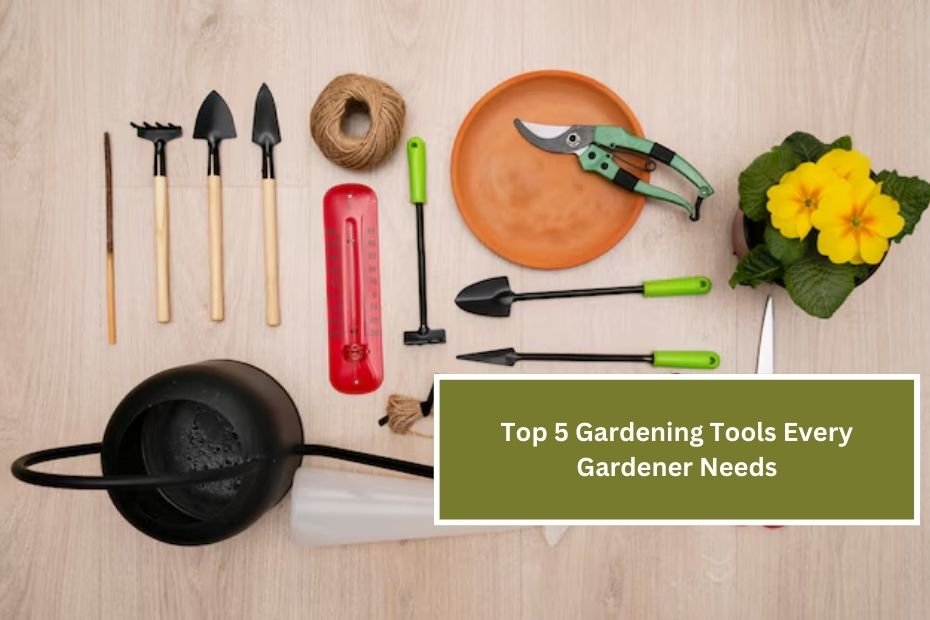Gardening is a rewarding hobby that allows you to connect with nature, beautify your surroundings, and grow your own food. Whether you’re a seasoned gardener or just starting, having the right tools can make your gardening experience more enjoyable and productive. In this article, we’ll explore the top five gardening tools every gardener needs, their uses, and tips for choosing the best ones.
1. Hand Trowel
What is a Hand Trowel?
A hand trowel is a small, handheld gardening tool that is perfect for digging, planting, and transferring small amounts of soil. It typically has a pointed, scoop-shaped metal blade and a sturdy handle.
Uses of a Hand Trowel
- Planting: A hand trowel is great for digging holes to plant flowers, vegetables, or herbs. Its size allows you to work in tight spaces.
- Transplanting: If you need to move plants from one location to another, a hand trowel helps lift them gently from the soil.
- Weeding: You can use a hand trowel to remove weeds by digging around the roots and pulling them out.
- Mixing Soil: When adding amendments like compost, a hand trowel helps mix them into the existing soil.
Choosing the Right Hand Trowel
When selecting a hand trowel, look for one with a comfortable grip and a sturdy blade. Stainless steel trowels are rust-resistant and durable, while those with wooden handles provide a comfortable grip. Consider the size of the blade based on your gardening needs; a wider blade is great for larger tasks, while a narrower one is better for precision work.
2. Pruning Shears
What are Pruning Shears?
Pruning shears, also known as secateurs or hand pruners, are essential tools for maintaining the health and appearance of your plants. They are designed to cut branches and stems with precision.
Uses of Pruning Shears
- Trimming Plants: Use pruning shears to trim back overgrown plants, helping them maintain their shape and encourage healthy growth.
- Deadheading Flowers: By removing spent blooms, you promote further flowering and keep your garden looking tidy.
- Removing Diseased or Damaged Growth: Pruning shears help eliminate any dead or diseased branches, which can prevent the spread of disease.
- Harvesting Fruits and Vegetables: These shears are also handy for harvesting produce, such as tomatoes or herbs.
Choosing the Right Pruning Shears
When selecting pruning shears, look for a pair that feels comfortable in your hand. There are two main types: bypass pruners, which work like scissors for clean cuts, and anvil pruners, which crush the stem against a flat surface. Bypass pruners are generally preferred for most gardening tasks. Ensure the blades are sharp and made of high-quality steel for durability.
3. Garden Fork
What is a Garden Fork?
A garden fork is a tool with several sturdy tines (prongs) that can be used for loosening and turning soil. It is often called a digging fork or a pitchfork, depending on its size and design.
Uses of a Garden Fork
- Turning Soil: A garden fork is perfect for breaking up compacted soil and turning it to aerate it, allowing for better root growth.
- Mixing Compost: If you are adding compost or other organic matter to your garden beds, a garden fork can help mix these materials thoroughly into the soil.
- Weeding: Use the tines to pull up deep-rooted weeds by loosening the soil around them.
- Breaking Up Clumps: If your soil has clumps or hard patches, a garden fork can help break them up for better planting conditions.
Choosing the Right Garden Fork
When choosing a garden fork, look for one with sturdy, durable tines and a comfortable handle. Stainless steel forks are ideal as they resist rust and are easy to clean. A fork with a longer handle provides better leverage for digging and turning the soil, while a shorter handle may be better for smaller spaces.
4. Watering Can
What is a Watering Can?
A watering can is a container with a spout that allows you to water your plants with precision. They come in various sizes and designs, making them a versatile tool for any gardener.
Uses of a Watering Can
- Watering Plants: A watering can is perfect for delivering water directly to the roots of your plants, ensuring they get the moisture they need.
- Fertilizing: If you’re using liquid fertilizers, a watering can is an excellent way to distribute them evenly throughout your garden.
- Seedling Care: When caring for delicate seedlings, a watering can provides gentle watering to avoid disturbing the soil.
Choosing the Right Watering Can
When selecting a watering can, consider its size based on the area you need to water. A smaller can is easier to handle, while a larger one means fewer trips to refill. Look for a can with a removable spout for flexibility and a comfortable handle for easy pouring. Some models also have a sprinkler head that allows for gentle watering.
5. Garden Gloves
What are Garden Gloves?
Garden gloves are protective hand coverings designed for gardening tasks. They come in various materials and styles to suit different needs.
Uses of Garden Gloves
- Protecting Hands: Gloves protect your hands from cuts, scrapes, and blisters while working with soil and plants.
- Preventing Allergic Reactions: Some people may be allergic to certain plants or soil, and gloves can help prevent reactions.
- Keeping Hands Clean: Gloves keep your hands clean while handling dirt, plants, and tools.
- Improving Grip: Many gloves have textured surfaces that provide a better grip on tools, reducing the risk of accidents.
Choosing the Right Garden Gloves
When selecting garden gloves, consider the material based on your gardening needs. Leather gloves are durable and provide excellent protection, while fabric gloves are lightweight and breathable for warmer weather. Look for gloves with reinforced fingertips for added protection and a snug fit for better control.
Conclusion
Gardening can be a fulfilling and enjoyable activity, but having the right tools is essential for success. A hand trowel, pruning shears, garden fork, watering can, and garden gloves are five must-have tools that will make your gardening experience easier and more productive. By investing in quality tools and learning how to use them effectively, you’ll be well on your way to creating a beautiful and thriving garden. Remember that gardening is not just about the tools but also about the joy and satisfaction it brings.

